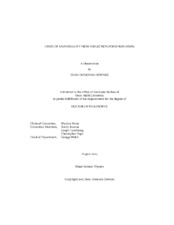| dc.description.abstract | This work aims to understand how cosmic inflation embeds into larger models of particle physics and string theory. Our work operates within a weakened version of the Landscape paradigm, wherein it is assumed that the set of possible Lagrangians is vast enough to admit the notion of a generic model. By focusing on slow-roll inflation, we examine the roles of both the scalar potential and the space of couplings which determine its precise form. In particular, we focus on the structural properties of the scalar potential, and find a surprising result: inflection point inflation emerges as an important —and under certain assumptions, dominant — possibility in the context of generic scalar potentials.
We begin by a systematic coarse graining over the set of possible inflection point inflation models using V.I. Arnold’s ADE classification of singularities. Similar to du Val’s pioneering work on surface singularities, these determine structural classes for inflection point inflation which depened on a distinct number of control parameters. We consider both single and multifield inflation, and show how the various structural classes embed within each other. We also show how such control parameters influence the larger physical models in to which inflation is embedded. These techniques are then applied to both MSSM inflation and KKLT-type models of string cosmology.
In the former case, we find that the scale of inflation can be entirely encoded within the super- potential of supersymmetric quantum field theories. We show how this relieves the fine-tuning required in such models by upwards of twelve orders of magnitude. Moreover, unnatural tuning between SUSY breaking and SUSY preserving sectors is eliminated without the explicit need for any hidden sector dynamics. In the later case, we discuss how structural stability vastly generalizes — and addresses — the Kallosh-Linde problem. Implications for the spectrum of SUSY breaking soft terms are then discussed, with an emphasis on how they may assist in constraining the inflationary scalar potential.
We then pivot to a general discussion of the FLRW-scalar phase space, and show how inflection points induce caustics — or dynamical fixed points — amongst the space of possible trajectories. These fixed points are then used to argue that for uninformative priors on the space of couplings, the likelihood of inflection point inflation scales with the inverse cube of the number of e-foldings. We point out the geometric origin for the known ambiguity in the Liouville measure, and demonstrate of inflection point inflation ameliorates this problem.
Finally we investigate the effect of the fixed point structure on the spectrum of density perturbations. We show how an anomaly in the Cosmic Mircowave Background data — low power at large scales — can be explained as a by product of the fixed point dynamics. | en |


